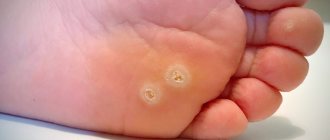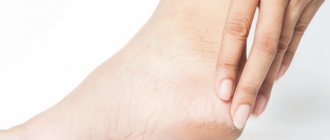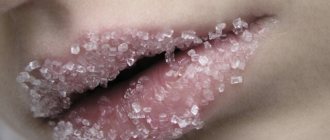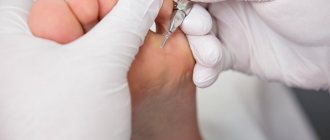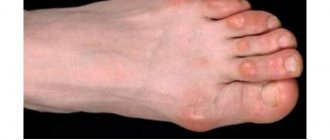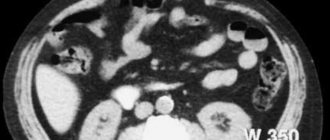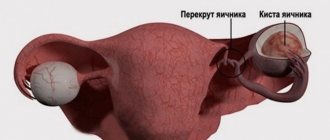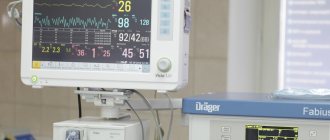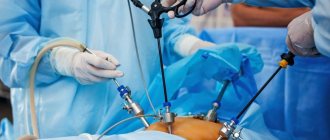Publication date: June 20, 2014.
There is no person who has not encountered such a skin problem as calluses in his life. They are different, and accordingly they are treated with different methods.
Sometimes calluses can be cured with the help of special ointments or baths (if the calluses are not advanced and do not yet have a deep core). Calluses include corns, dry calluses, and thick keratinized layers of skin on the feet. In these cases, surgical removal of calluses on the feet and surgical removal of corns can be replaced by a simpler and painless procedure - resurfacing. Grinding is carried out with a special grinding machine, does not take much time and does not create post-procedure discomfort. The only disadvantage of this method is the fragility of the achieved effect. Depending on the characteristics of the skin, gait and lifestyle, re-keratinization can occur either after a few months or after a few days.
Neglected calluses with a deep internal core cause acute pain; treatment can take a long time and is useless. Trying to get rid of the callus core on your own is also not worth it: in addition to the fact that this is dangerous in itself, you can also get an infection, and the problem will become much more serious.
Medical diagnosis of callus
Core-type calluses are fairly easy to diagnose.
After an in-person consultation, a dermatologist can provide a conclusion and diagnosis about the type of skin growth.
The only difficulty may be differentiating an ingrown callus from Verruca plantaris (plantar wart).
Because they have the same location and appearance.
You can distinguish a callus from a wart by the following features:
- An ingrown callus is not accompanied by bleeding even with strong pressure on it.
- A wart, unlike a callus, is not a single formation. Typically, upon examination, several warts that resemble cauliflower can be identified.
- The callus in its central zone has a small depression, which can be seen upon detailed examination. In the case of a wart, the HPV formation consists of thin fibers; petechiae (black dots) are observed on top, which bleed when injured.
- If a wart is present, pain occurs when the lesion itself is palpated; there is no pain when walking. In the case of calluses, pain is observed with any mechanical movement.
To confirm the diagnosis and determine the cause of the disease, the dermatologist prescribes a blood test for diabetes mellitus.
Also an analysis to determine the human papillomavirus, to exclude HPV.
Additionally, the doctor can redirect the patient to other specialized specialists.
See a podiatrist (a doctor who treats foot pathologies), a rheumatologist or an orthopedist.
An important point is to exclude Morton's neuroma.
Morton's neuroma is a benign or non-cancerous growth of fibrous tissue.
Develops in the area of the tibial nerve, most often between the third and fourth fingers.
The pathology is accompanied by thickening of the plantar nerve, pain when walking, and a feeling of numbness in the fingers.
The disease is also known as Morton's metatarsalgia, plantar neuroma, and intermetatasal neuroma.
Methods for treating and removing ingrown calluses
The only and effective method of eliminating this problem on the legs is to remove the stratum corneum of the callus and its root.
In this case, it is important to completely remove not only the surface of the callus, but also the root.
Otherwise, the risk of relapse reaches 100%.
There are various methods for removing calluses; the optimal treatment option is selected individually.
Depending on the clinical signs, the neglect of the case and how deep the root has penetrated into the layers of the dermis.
1.General information
Calluses are a widespread phenomenon, which in the vast majority of cases does not come to the attention of outpatient or, especially, inpatient surgeons. The exception is rare cases of complications that require surgery and subsequent intensive treatment.
This development of events is mainly due to the fact that “ordinary” calluses are opened at home without observing the basic rules of asepsis and the principles of primary medical self-help. Therefore, it will not be amiss to remember what a skin callus is and what measures need to be taken to eliminate and prevent it.
We emphasize that in this case we are talking only about skin calluses; Bone calluses are a different kind of pathology that should be considered separately.
A must read! Help with treatment and hospitalization!
Removing callus using drilling
This procedure can be carried out in a pedicure salon.
During the manipulation, a special device resembling a drill is used.
The procedure does not require the use of anesthesia.
Since it is not accompanied by pain.
Drilling/excision of callus areas is carried out using special attachments.
An antibacterial ointment is first placed in the deepening of the callus to prevent the development of the inflammatory process.
For the first few days, the patient may feel minor discomfort, which goes away on its own and does not require treatment.
Dry callus is removed using a similar method, but provided that it is not neglected.
The drilling procedure has certain disadvantages:
- If the rod is located deep enough, this manipulation may be ineffective. Often several manipulations are required to completely remove the callus.
- In the process of drilling out the keratinized area of the dermis, damage to healthy skin is possible. The procedure requires a highly qualified specialist.
- This type of callus removal is a contact type of procedure, which means it is accompanied by an increased risk of infection.
3. Symptoms and diagnosis
There are several types of calluses, which differ significantly both etiologically and clinically. For example, a core callus is usually formed in response to the introduction of a small foreign body (a splinter, a chip that has gotten under the skin, a piece of stone, etc.) and is a compaction that goes deep, visible from the outside as a cap with a central crater. Corns are also a type of callus - keratinized areas on the soles of the feet, sometimes of a fairly large area, without a clear boundary with the skin of normal elasticity and moisture.
The most obvious and significant difference is between the two main categories of calluses: soft and dry.
Soft (water) calluses at the stage of formation are a locally irritated, reddened, weeping, painful area of skin, which quickly transforms into a blister or sac filled with serous fluid (“dropsy”); if the exposure does not stop at this stage, the soft callus inevitably breaks through to form an open wound. The penetration of pathogenic microorganisms triggers an infectious-inflammatory process, the classic signs of which are swelling, hyperemia, clearly localized pain, and local fever. The most serious of the complications mentioned above include purulent abscesses, cellulitis, and osteomyelitis.
The callus is dry (hard), looks like a local rounded keratinization, usually yellow-gray, with a radius of several millimeters to several centimeters, clearly demarcated from the surrounding skin and rising (sometimes significantly) above its level. Any pain or discomfort occurs, as a rule, only when such a callus is pressed or laterally displaced.
The most common areas for the formation of calluses are the distal, terminal sections of the hands and feet (phalangeal folds, fingertips, interdigital spaces, skin of the palms and soles), as well as elbows and knees. More specific calluses can also occur in other areas: for example, in professional violinists, constant contact with the hard varnished wood of the soundboard causes the skin on the lower jaw bone on the left to become rough.
As a rule, there is no need for additional diagnostics: a dermatologist or surgeon at first glance distinguishes a callus from an inflammatory cyst or abscess, scleroderma skin changes, warts, swelling due to joint inflammation, etc. However, in some cases, a differential diagnostic study (for example, histological or ultrasound) may be necessary.
About our clinic Chistye Prudy metro station Medintercom page!
Removal of callus with liquid nitrogen (cryodestruction)
Cryodestruction is an innovative, highly effective method of removing calluses on the foot, heel or toes using liquid nitrogen.
During the procedure, the keratinized area of the skin is frozen, after which the destruction of the callus is observed.
It has been noted that the procedure is associated with an extremely low rate of callus re-development.
Many dermatologists note that no other method for removing core calluses gives results as favorable as cryodestruction.
Removing callus with liquid nitrogen takes about 10-20 minutes.
It is performed under local anesthesia, so the procedure is completely painless and safe.
Side effects are extremely rare (no more than 3% of cases).
Include callus recurrence, pain, discomfort, bleeding, infection, scarring.
The first few days after the procedure, the formation of a cold bubble is observed, which under no circumstances should be pierced.
Within 10-14 days, the healing process occurs; a crust forms in place of the bubble, which falls off on its own.
The process is not accompanied by the formation of scars.
The procedure is usually well tolerated, with minor discomfort possible.
Some disadvantages of cryotherapy:
- If the rod is extremely deep, cryodestruction is not always able to completely rid the patient of the callus.
- If you do not properly care for the skin after the procedure, there is a risk of an infectious process.
- Freezing the callus with liquid nitrogen is not used when large areas of the epidermis are affected. Cryodestruction used on large calluses can lead to a number of complications. For this reason, in advanced cases, they resort to other therapeutic methods.
2. Reasons
The immediate cause of the formation of calluses on the skin is a local mechanical effect, stereotypical in nature (repeated friction, vibrating pressure, etc.). If in a given area the combination of intensity and duration of such exposure exceeds a certain threshold of strength, stability, and density of the skin, the cellular layers are damaged, regenerative mechanisms do not have time to restore the tissue, and certain pathological changes begin in it, which, again, depend on the strength , duration and vectors of mechanical irritation.
With strong friction, unusual for any area, a callus can form and spontaneously open in a matter of minutes; on the contrary, with soft, almost imperceptible, but constant pressure and rubbing, years may pass until the skin thickens and hardens adequately to the impact. In general, the adaptive capabilities of skin tissue are very great: it can adapt (hardening, as they say, to stone hardness) even to oars, a shovel or a heavy lumberjack axe.
The most typical origin of calluses is working with hand tools and equipment, playing musical instruments (especially stringed ones), and regular training on sports equipment. An extensive and diverse group is also formed by calluses associated with shoes: improperly selected, tight or too loose shoes that do not correspond to individual orthopedic features (flat feet, high instep, joint inflammation, etc.), rough and simply poorly cut and sewn shoes can become cause serious problems.
Visit our Therapy page
Laser excision of callus
Laser callus removal remains a priority treatment method.
Allows you to effectively eliminate the problem with minimal risk of recurrence.
The laser penetrates into the deep layers of the dermis, which makes it possible to remove the root completely, rather than partially.
The operation of the device is based on the reproduction of a laser beam with special light properties:
- Monochromatic: Has only one specific wavelength or color.
- Coherence: Vibrates in the same phase or synchronously.
- Divergence: the beam works in a given direction.
During the manipulation, the epidermal layer is “burned out”, one after another.
The manipulation requires the use of an anesthetic.
The average session duration is no more than 10-15 minutes.
Before using the laser, the callus is treated with antiseptic drugs.
After laser irradiation, a dense crust forms, which will disappear after 10-14 days.
Laser treatment to remove calluses leads to cell regeneration.
It has an anti-inflammatory effect and stimulates the local immune system.
Thus, it promotes rapid healing of wounds.
However, the main advantage of the laser is the complete removal of callus even with a deep root location.
Often, one visit to a dermatologist is enough to effectively eliminate the problem.
Radio wave removal of callus
Callus removal by radio wave is carried out using a special device “Surgitron”.
The Surgitron device uses advanced radio wave technology.
Ensures accuracy, versatility and safety of medical procedures.
The surgical electrode, which is a tungsten wire, emits 3.8 MHz radio waves and slides through the tissue without putting pressure on it.
The pathologically changed area is evaporated, which leads to the destruction of the callus.
An important advantage is that the electrode is self-sterilizing during use, which reduces the likelihood of infection after the procedure.
Other benefits of radio wave treatment:
- Excellent cosmetic results; the manipulation is not accompanied by the formation of scar tissue.
- Fast recovery for the patient, since the treatment process does not affect the healthy tissue surrounding the callus.
- Reduced postoperative pain; in addition, the manipulation itself is not accompanied by pain.
After radio wave removal, the callus becomes covered with a crust, which falls off on its own after 7-10 days.
After which a new, healthy layer of new skin appears, which over time blends with the natural color of the epidermis.
Treatment of callus with medications
It is immediately worth noting that drug treatment of calluses has the least therapeutic effectiveness.
This phenomenon is associated with the inability of drugs to penetrate deep into tissues, eliminating the root of the formation.
The products used for core calluses often contain keratolytic components and can be effective at the beginning of callus development.
As a rule, products based on salicylic acid are used.
Salicylic acid is a keratoplastic and keratolytic agent.
In addition, it has an antibacterial and antifungal effect.
Salicylic acid works by softening keratin, a natural protein that is part of the skin's structure and produced by the body.
The drug has a softening effect on the stratum corneum of the dermis, which facilitates its removal.
Salicylic acid is often used in combination with other substances.
Allows for a higher therapeutic effect.
When using salicylic acid preparations, the simultaneous use of the following drugs is not recommended:
- Alcohol-containing medications.
- Any other local medications that contain dibenzoyl peroxide or retinoid.
- Soapy substances that have a drying effect.
- Cosmetics that have an exfoliating effect.
Traditional medicine in the treatment of calluses
Folk remedies cannot affect the development of callus and are not an effective treatment method.
The treatment and removal of callus must be carried out by a qualified specialist.
This will minimize negative consequences and complications.
It is necessary to begin treatment of callus in the early stages of its development.
When there is still a chance to get rid of the problem without resorting to surgical methods.
As it progresses, the root of the callus will penetrate into the deeper layers of the epidermis.
Then it may be necessary to use more radical and expensive methods of therapy.
4.Treatment
When opening a soft callus at home, the first priority is antiseptic measures: the affected area should be thoroughly washed and disinfected, the needle should be sterilized (it is better to use the sterile needle included with any disposable syringe). After opening and expiration of the contents, the wound surface should also be treated with a disinfectant solution, carefully remove flaps of dead skin with a sterilized manicure instrument (do not tear off under any circumstances!), apply antibiotic ointment and, if necessary, a protective bandage or bactericidal patch. There is also a wide range of traditional medicine, the consideration of which is beyond the scope of this article.
To eliminate and prevent dry calluses, therapeutic and hygienic creams, gels, ointments, and liquids are offered; You can also find countless recommendations for steaming, using pumice, softening compresses, etc. However, it is more important to remember the following.
At the first signs of an infectious-inflammatory process, as well as when a rapid change in the size, shape, color of the callus and/or sensations associated with it begins, you should immediately consult a doctor (surgeon or dermatologist). Currently, many methods for the safe removal and treatment of calluses are successfully used, taking into account the individual nuances of each case: radio wave, laser, cryotherapeutic, microsurgical techniques.
